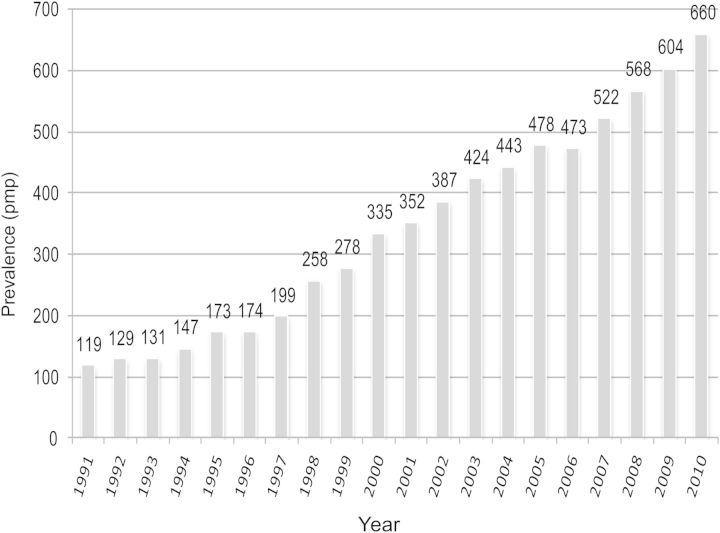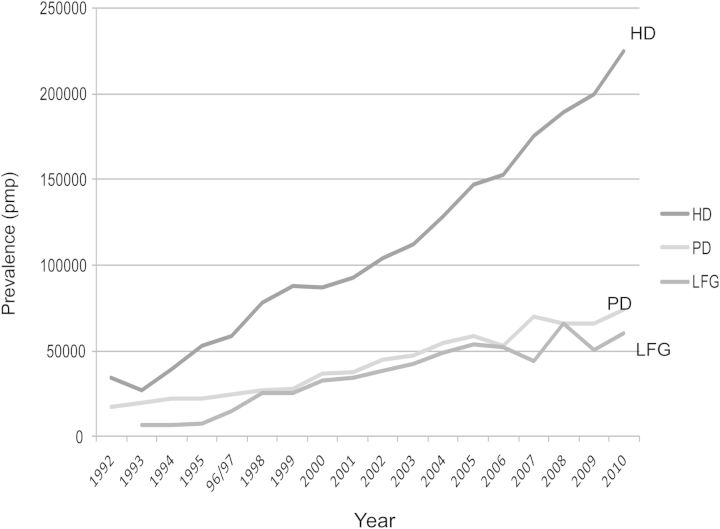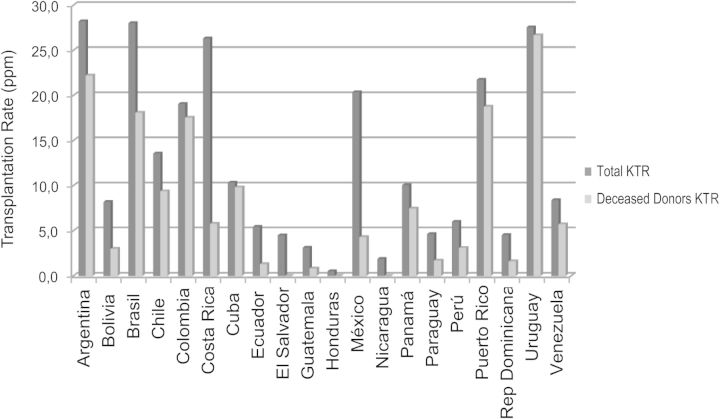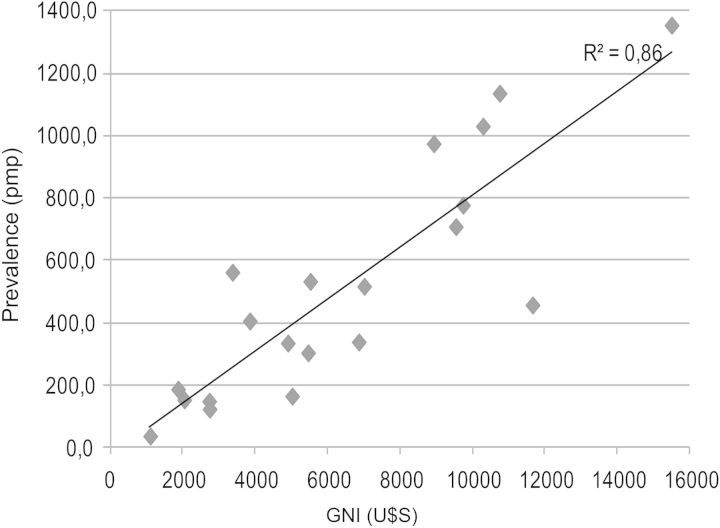Abstract
The Latin American Dialysis and Renal Transplant Registry (RLADTR) was founded in 1991; it collects data from 20 countries which are members of Sociedad Latinoamericana de Nefrología e Hipertension. This paper presents the results corresponding to the year 2010. This study is an annual survey requesting data on incident and prevalent patients undergoing renal replacement treatment (RRT) in all modalities: hemodialysis (HD), peritoneal dialysis (PD) and living with a functioning graft (LFG), etc. Prevalence and incidence were compared with previous years. The type of renal replacement therapy was analyzed, with special emphasis on PD and transplant (Tx). These variables were correlated with the gross national income (GNI) and the life expectancy at birth. Twenty countries participed in the surveys, covering 99% of the Latin American. The prevalence of end stage renal disease (ESRD) under RRT in Latin America (LA) increased from 119 patients per million population (pmp) in 1991 to 660 pmp in 2010 (HD 413 pmp, PD 135 pmp and LFG 111 pmp). HD proportionally increased more than PD, and Tx HD continues to be the treatment of choice in the region (75%). The kidney Tx rate increased from 3.7 pmp in 1987 to 6.9 pmp in 1991 and to 19.1 in 2010. The total number of Tx's in 2010 was 10 397, with 58% deceased donors. The total RRT prevalence correlated positively with GNI (r2 0.86; P < 0.05) and life expectancy at birth (r2 0.58; P < 0.05). The HD prevalence and the kidney Tx rate correlated significantly with the same indexes, whereas the PD rate showed no correlation with these variables. A tendency to rate stabilization/little growth was reported in the most regional countries. As in previous reports, the global incidence rate correlated significantly only with GNI (r2 0.63; P < 0.05). Diabetes remained the leading cause of ESRD. The most frequent causes of death were cardiovascular (45%) and infections (22%). Neoplasms accounted for 10% of the causes of death. The prevalence of RRT continues to increase, particularly in countries with 100% public health or insurance coverage for RRT, where it approaches rates comparable to those displayed by developed countries with a better GNI. The incidence also continues to increase in both countries that have not yet extended its coverage to 100% of the population as well as in those that have an adequate program for timely detection and treatment of chronic kidney disease (CKD) and its associated risk factors. PD is still an underutilized strategy for RRT in the region. Even though renal Tx is feasible, its growth rate is still not as fast as it should be in order to compensate for the increased prevalence of patients on waiting lists. Diagnostic and prevention programs for hypertension and diabetes, appropriate policies promoting the expansion of PD and organ procurement as well as transplantation as cost-effective forms of RRT are needed in the region. Regional cooperation among Latin American countries, allowing the more developed to guide and train others in starting registries and CKD programs, may be one of the key initiatives to address this deficit.
Keywords: peritoneal dialysis, hemodialysis, kidney transplantation, chronic renal failure, Latin America
Introduction
Latin America (LA) is a region extending from Mexico and the Caribbean Islands in the north to Argentina and Chile in the south. It is characterized by the use of Roman-derived languages (Spanish and Portuguese) and a wide ethnic diversity. In this true melting pot, the original immigrants from Spain and Portugal are now admixed with European immigrants who escaped from the World Wars, Native Americans (now the majority in Bolivia and in very high numbers in Guatemala, Peru and Mexico) and the descendants of the slaves migrating from Africa (very high numbers in Brazil; fewer in Colombia and Uruguay). The racial admixture in Brazil is so big that genetic studies arrived at the conclusion that skin color cannot identify the race. Most of them are mulattos (pardos in the vernacular); in Uruguay, the mix with predominantly Spaniards is the rule. Usually, the father genes are Spanish or Portuguese [1, 2].
The region is going through a fast demographic and epidemiologic transition process, characterized by a reduction in mortality and birth rates, accompanied by rapid lifestyle changes. This is associated with the population's movements from rural areas to big cities, with an increase in chronic non-communicable diseases, including chronic kidney disease (CKD). However, the fight against infections continues, especially emerging, such as HIV, and re-emerging diseases such as dengue and Chagas disease. From the socioeconomic point of view, significant improvements have occurred in the last 10 years, such as an increasing gross national income (GNI), from 3683 USD in the year 2001 to 7821 USD in 2010, and an increased life expectancy at birth from 71.6 (2000) to 74 (2010) [3–5]. CKD represents a major challenge for the region, due to its epidemic proportions and high burden to the population affected and to public health systems. Epidemiological information to guide the planning of CKD care is scarce in the region.
The Latin American Dialysis and Renal Transplant Registry (RLADTR) was founded in 1991; it collects data from 20 countries, all members of the Sociedad Latinoamericana de Nefrología e Hipertension. It has published several reports [6–11] and its continuity has implied a sustained effort of the entire Latin American nephrology community.
This paper presents the results corresponding to the year 2010.
Methods
Our methods have previously been reported [6–11]. The participant countries complete an annual survey requesting data on incident and prevalent patients undergoing renal replacement treatment (RRT) in all modalities: hemodialysis (HD), peritoneal dialysis (PD), living with a functioning graft (LFG) and number of dialysis and transplant (Tx) centers, etc. Based on these data, prevalence and incidence rates are determined by December 31 and reported in patients per million population (pmp). Prevalence and incidence were compared with previous years. The type of renal replacement therapy was analyzed, with special emphasis on PD and Tx. These variables were correlated with the GNI and the life expectancy at birth. The causes of admission to dialysis and death were described.
For the statistical analysis, the Pearson (r) and determination (r2) coefficients were applied and a P-value <0.05 was considered significant.
Results
Twenty countries participated in the surveys, covering 99% of the Latin American. Table 1 describes the most prominent variables analyzed.
Table 1.
LADTR: population, socioeconomic indexes, prevalence and incidence rates by country
| Country | Population in millions | GNI | Life expectancy at birth | Prevalence rates (pmp) |
Total RRT | Incidence rate | Kidney Tx number | Kidney Tx rate | |||
|---|---|---|---|---|---|---|---|---|---|---|---|
| HD | PD | Total dialysis | LFG | ||||||||
| Argentina | 40 370 000 | 9740 | 76 | 616.3 | 27.2 | 643.5 | 134.3 | 777.8 | 152.5 | 1140 | 28.2 |
| Bolivia | 9 995 000 | 2040 | 66 | 103.9 | 17.7 | 121.7 | 33.0 | 153.1 | ND | 82 | 8.2 |
| Brazil | 165 153 000 | 9540 | 73 | 530.8 | 22.1 | 552.9 | 155.8 | 708.7 | 173.7 | 4630 | 28.0 |
| Chile | 17 149 000 | 10 750 | 79 | 901.6 | 39.1 | 940.8 | 195.9 | 1136.7 | 174.9 | 233 | 13.6 |
| Colombia | 46 448 000 | 5520 | 73 | 306.5 | 139.5 | 446.1 | 87.0 | 533.1 | 141.9 | 886 | 19.1 |
| Costa Rica | 4 669 000 | 6860 | 79 | 29.1 | 20.8 | 49.9 | 288.9 | 338.8 | ND | 123 | 26.3 |
| Cuba | 11 298 000 | 5460 | 79 | 222.6 | 10.2 | 232.8 | 71.2 | 303.9 | 99.0 | 117 | 10.4 |
| Ecuador | 14 490 000 | 3850 | 75 | 352.0 | 34.5 | 386.5 | 19.5 | 405.9 | 127.7 | 79 | 5.5 |
| El Salvador | 6 218 000 | 3370 | 72 | 161.0 | 335.2 | 496.1 | 66.3 | 562.4 | ND | 28 | 4.5 |
| Guatemala | 14 334 000 | 2740 | 71 | 76.9 | 17.6 | 94.5 | 28.8 | 123.3 | 10.7 | 45 | 3.1 |
| Honduras | 7 619 000 | 1870 | 73 | 167.1 | 16.3 | 183.4 | 3.8 | 187.2 | 197.1 | 4 | 0.5 |
| Mexico | 112 364 000 | 8930 | 77 | 381.9 | 485.0 | 866.9 | 108.0 | 974.9 | 458.0 | 2290 | 20.4 |
| Nicaragua | 5 813 000 | 1100 | 74 | 29.2 | 2.6 | 31.8 | 5.2 | 37.0 | ND | 11 | 1.9 |
| Panama | 3 474 000 | 7010 | 76 | 340.0 | 96.7 | 436.7 | 80.6 | 517.3 | ND | 35 | 10.1 |
| Paraguay | 6 458 000 | 2730 | 72 | 126.2 | 1.5 | 127.7 | 20.9 | 148.7 | 33.3 | 30 | 4.6 |
| Peru | 29 272 000 | 4900 | 74 | 230.7 | 39.1 | 269.8 | 65.5 | 335.3 | 34.3 | 176 | 6.0 |
| Puerto Rico | 3 998 000 | 15 500 | 79 | 1096.5 | 85.5 | 1182.1 | 173.1 | 1355.2 | 368.9 | 87 | 21.8 |
| Dominican Republic | 9 907 000 | 5020 | 73 | 127.4 | 8.9 | 136.3 | 28.8 | 165.0 | ND | 45 | 4.5 |
| Uruguay | 3 373 000 | 10 290 | 76 | 671.5 | 73.8 | 745.3 | 285.8 | 1031.1 | 161.0 | 93 | 27.6 |
| Venezuela | 31 267 000 | 11 660 | 74 | 339.8 | 58.5 | 398.3 | 59.1 | 457.4 | ND | 263 | 8.4 |
| Total no. of countries, LA | 543 669 000 | 7821 | 74 | 413.4 | 135.7 | 549.1 | 111.2 | 660.3 | 190.8 | 10 397 | 19.1 |
GNI, gross national income; HD, hemodialysis; LA, Latin America; LADTR, Latin American Dialysis and Transplant Registry; LFG, living with a kidney functioning graft; ND, not reported; PD, peritoneal dialysis; RRT, renal replacement treatment; Tx, transplant.
The prevalence of end stage renal disease (ESRD) under RRT in LA increased from 119 patients pmp in 1991 to 660 pmp in 2010 (HD 413 pmp, PD 135 pmp and LFG 111 pmp; Figure 1). The highest rates were reported by Puerto Rico (1355); Argentina, Mexico, Uruguay and Chile reported rates between 777 and 1136.
Fig. 1.
Latin American Dialysis and Renal Transplantation Registry 1991–2010. RRT prevalence, all modalities.
Although the increase of RRT patients has occurred in all modalities, HD proportionally increased more than PD and Tx (Figure 2). The growth rate for these modalities compared with 2008 was 20, 14 and 5% for HD, PD and Tx, respectively. HD continues to be the treatment of choice in the region (75%), and 39% of HD patients are located in Brazil. PD prevailed only in El Salvador and Mexico (67.6 and 55.9%, respectively); PD was also common in Colombia, although the percentage of Colombian PD patients has consistently decreased in the last 10 years from 54% in 2000 to 31.3% in 2010. Nicaragua decreased the percentage of PD patients (8.1%), according to a significant increase in the number of patients on HD in the last 2 years. In the remaining countries, between 1.2 and 41.6% of the patients were on PD; 73% of the PD patients were located in Mexico.
Fig. 2.
Evolution of the number of RRT patients in LA by treatment modality (1991–010). HD, PD and functional kidney grafts (FKG).
The kidney Tx rate increased from 3.7 pmp in 1987 to 6.9 pmp in 1991 and to 19.1 in 2010 (Figure 3), although it showed remarkable variations in that year, from 28.2 pmp in Argentina to 0.5 pmp in Honduras. Owing to the higher population, numerically, a higher number was registered in Brazil, with 4630 kidney Tx's. A total of 197 double kidney–pancreas Tx's were performed (Brazil 129, Argentina 58, Uruguay 4, Colombia 3, Cuba 1, Chile 1 and Peru 1). The total number of Tx's in 2010 was 10 397, with 58% deceased donors [the highest percentages were observed in Uruguay (96.8%), Cuba (94.9%), Colombia (92%) and Argentina (78.7%); Figure 4].
Fig. 3.
Evolution of kidney transplant rate (pmp of habitants) in LA (1987–2010).
Fig. 4.
Deceased donors and kidney transplant rate (pmp of habitants) by country (2010).
The total RRT prevalence correlated positively with GNI (r2 0.86; P < 0.05) and life expectancy at birth (r2 0.58; P < 0.05; Figure 5). The HD prevalence and the kidney Tx rate correlated significantly with the same indexes, whereas the PD rate showed no correlation with these variables.
Fig. 5.
GNI (USD) per capita and correlation with the prevalence of RRT patients (2010).
Data from incidence were sent by 13 countries comprising 87% of the Latin American population (Table 1). A wide rate variation in incidence is observed from 458 in Mexico to 10.7 pmp in Guatemala. A tendency to rate stabilization/little growth was reported in the most regional countries, except Ecuador with a significant growth rate incidence (38 in 2008 to 127 ppm in 2010). As in previous reports, the global incidence rate correlated significantly only with GNI (r2 0.63; P < 0.05).
Diabetes remained the leading cause of ESRD, the highest incidence reported by Puerto Rico (66.8%), Mexico (61.8%) and Colombia (42.5%), and the lowest by Cuba (26.2%) and Uruguay (23.2%). The incidence of diabetes showed no correlation with GNI and life expectancy at birth.
The most frequent causes of death were cardiovascular (45%) and infections (22%). Neoplasms accounted for 10% of the causes of death.
Discussion
This report shows that the prevalence of RRT continues to increase, particularly in countries with 100% public health or insurance coverage for RRT; where it approaches rates comparable to those displayed by developed countries with a better GNI.
In these countries where the incidence shows a tendency to stabilize and/or to a slower growth ratio, the increase in prevalence is likely the result of improving life expectancy of the general population and survival of those individuals undergoing RRT.
The incidence also continues to increase in both countries that have not yet extended its coverage to 100% of the population as well as in those that have an adequate program for timely detection and treatment of CKD and its associated risk factors.
PD is still an underutilized strategy for RRT in the region; this fact particularly contrasts with the continued expansion of HD. The causes are presumably multifactorial, the shortage of trained nephrologists and nurses on the one hand, and the lack of financial support and health policies on the other. This approach could be adequate to overcome particular geographical demands and to reduce the need for long distance travel to receive treatment in some specific regions. The chance that dialysis solutions can be produced in the area should be considered cost effective.
Even though renal Tx is feasible, available and an increasingly used modality for RRT in all Latin American countries, its growth rate is still not as fast as it should be in order to compensate for the increased prevalence of patients on waiting lists. This fact ratifies the necessity to consider Tx programs and procurement of suitable organs.
Diabetes and hypertension are the leading causes of admission to dialysis; prevention programs for chronic kidney disease should include early diagnosis and treatment of these conditions. Cardiovascular and infectious complications are still the major causes of death in patients undergoing renal replacement therapy.
In most of the regional countries, reporting is voluntary; therefore, the Latin American registry has weaknesses such as a wide variability in data consistency. As an example, data from Mexico are extrapolated from other local registries (Morelos and Guadalajara) and the number of prevalent patients with functioning allograft is sometimes a simple estimate.
Finally, this registry has several strengths. Among them, its continuity (conducted since 1991), its contribution to the development of National Registries allowing comparisons among different countries and other records along with the generation of trends for the treatment of CKD in LA must be emphasized.
In conclusion, diagnostic and prevention programs for hypertension and diabetes, appropriate policies promoting the expansion of PD and organ procurement as well as transplantation as cost-effective forms of RRT are needed in the region.
Regional cooperation among Latin American countries, allowing the more developed to guide and train others in starting registries and CKD programs may be one of the key initiatives to address this deficit.
Acknowledgements
The authors thank A. Cusumano, J. Fernandez-Cean, J. Flores, R. Gómez Acevedo, Z. Cruz de Trujillo, O. Noboa, A. Ferreiro, W. Douthat.
Conflict of interest statement. None declared.
References
- 1.Keen B, Haynes K. A History of Latin America. 8th edn. Belmont, CA: Wadsworth Publishing; 2008. [Google Scholar]
- 2.Sans M. Admixture studies in Latin America: from the 20th to the 21st century. Hum Biol. 2000;72:155–177. [PubMed] [Google Scholar]
- 3.Economic and Social Panorama of the Community of Latin American and Caribbean States. 2013. http://www.cepal.org/publicaciones/xml/5/52075/EconomicandSocialPanorama.pdf. (1 March 2013, date last accessed) [Google Scholar]
- 4.Demographic Observatory. Population Projections. 2012 http://www.eclac.org/publicaciones/xml/1/50561/ObservatorioDemografico2012.pdf.pdf . (1 March 2013, date last accessed) [Google Scholar]
- 5.Data-The World Bank. http://data.worldbank.org/region/latin-americaand-caribbean. (1 March 2013, date last accessed) [Google Scholar]
- 6.Mazzuchi N, Schwedt E, Fernández JM, et al. Latin American Registry of dialysis and renal transplantation: 1993 annual dialysis data report. Nephrol Dial Transplant. 1997;12:2521–2527. doi: 10.1093/ndt/12.12.2521. [DOI] [PubMed] [Google Scholar]
- 7.González-Martínez F, Agost-Carreño C, Silva-Ancao M, et al. 1993 Renal Transplantation Annual Data Report: Dialysis and Renal Transplantation Register of the Latin American Society of Nephrology and Hypertension. Transplant Proc. 1997;29:257–260. doi: 10.1016/s0041-1345(96)00086-3. [DOI] [PubMed] [Google Scholar]
- 8.Schwedt E, Fernandez J, Gonzalez F, et al. Renal replacement therapy in Latin America during 1991–1995. Latin American Registry Committee. Transplant Proc. 1999;31:3083–3084. doi: 10.1016/s0041-1345(99)00683-1. [DOI] [PubMed] [Google Scholar]
- 9.Cusumano AM, Di Gioia C, Hermida O, et al. Latin American Registry of Dialysis and Renal Transplantation. The Latin American Dialysis and Renal Transplantation Registry Annual Report 2002. Kidney Int Suppl. 2005;97:S46–S52. doi: 10.1111/j.1523-1755.2005.09708.x. [DOI] [PubMed] [Google Scholar]
- 10.Cusumano AM, Romao JE, Poblete Badal H, et al. Latin-American Dialysis and Kidney Transplantation Registry: data on the treatment of end-stage renal disease in Latin America. G Ital Nefrol. 2008;25:547–553. [PubMed] [Google Scholar]
- 11.Cusumano AM, Gonzalez Bedat MC, García-García G, et al. Latin American Dialysis and Renal Transplant Registry: 2008 report (data 2006) Clin Nephrol. 2010;74(Suppl 1):S3–8. [PubMed] [Google Scholar]







